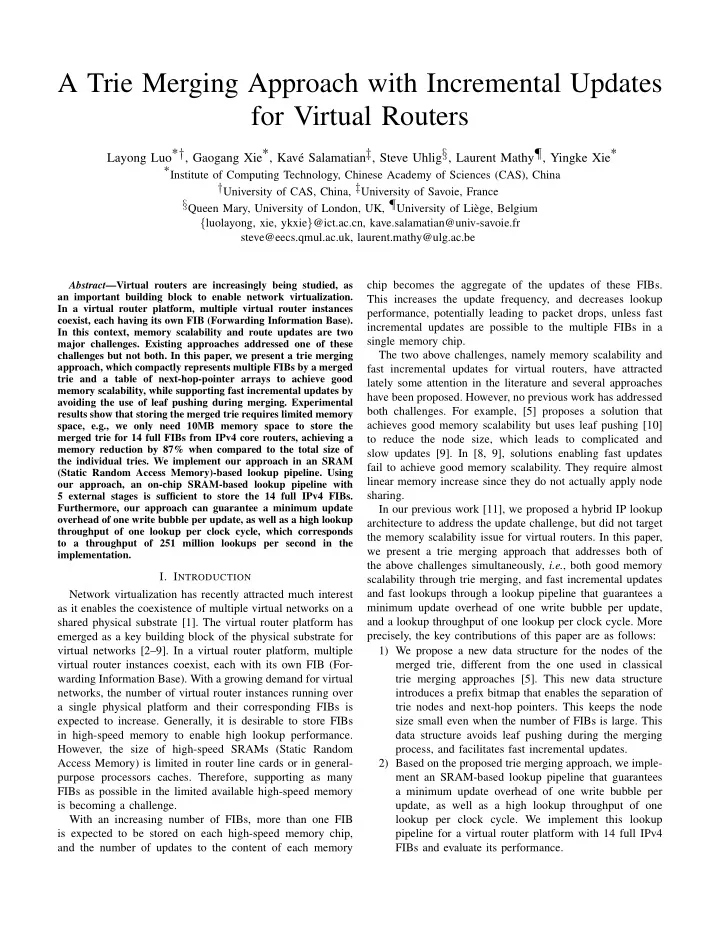

A Trie Merging Approach with Incremental Updates for Virtual Routers Layong Luo* † , Gaogang Xie*, Kav´ e Salamatian ‡ , Steve Uhlig § , Laurent Mathy ¶ , Yingke Xie* *Institute of Computing Technology, Chinese Academy of Sciences (CAS), China † University of CAS, China, ‡ University of Savoie, France § Queen Mary, University of London, UK, ¶ University of Li` ege, Belgium { luolayong, xie, ykxie } @ict.ac.cn, kave.salamatian@univ-savoie.fr steve@eecs.qmul.ac.uk, laurent.mathy@ulg.ac.be chip becomes the aggregate of the updates of these FIBs. Abstract —Virtual routers are increasingly being studied, as an important building block to enable network virtualization. This increases the update frequency, and decreases lookup In a virtual router platform, multiple virtual router instances performance, potentially leading to packet drops, unless fast coexist, each having its own FIB (Forwarding Information Base). incremental updates are possible to the multiple FIBs in a In this context, memory scalability and route updates are two single memory chip. major challenges. Existing approaches addressed one of these The two above challenges, namely memory scalability and challenges but not both. In this paper, we present a trie merging approach, which compactly represents multiple FIBs by a merged fast incremental updates for virtual routers, have attracted trie and a table of next-hop-pointer arrays to achieve good lately some attention in the literature and several approaches memory scalability, while supporting fast incremental updates by have been proposed. However, no previous work has addressed avoiding the use of leaf pushing during merging. Experimental both challenges. For example, [5] proposes a solution that results show that storing the merged trie requires limited memory achieves good memory scalability but uses leaf pushing [10] space, e.g., we only need 10MB memory space to store the merged trie for 14 full FIBs from IPv4 core routers, achieving a to reduce the node size, which leads to complicated and memory reduction by 87% when compared to the total size of slow updates [9]. In [8, 9], solutions enabling fast updates the individual tries. We implement our approach in an SRAM fail to achieve good memory scalability. They require almost (Static Random Access Memory)-based lookup pipeline. Using linear memory increase since they do not actually apply node our approach, an on-chip SRAM-based lookup pipeline with sharing. 5 external stages is sufficient to store the 14 full IPv4 FIBs. Furthermore, our approach can guarantee a minimum update In our previous work [11], we proposed a hybrid IP lookup overhead of one write bubble per update, as well as a high lookup architecture to address the update challenge, but did not target throughput of one lookup per clock cycle, which corresponds the memory scalability issue for virtual routers. In this paper, to a throughput of 251 million lookups per second in the we present a trie merging approach that addresses both of implementation. the above challenges simultaneously, i.e. , both good memory I. I NTRODUCTION scalability through trie merging, and fast incremental updates and fast lookups through a lookup pipeline that guarantees a Network virtualization has recently attracted much interest minimum update overhead of one write bubble per update, as it enables the coexistence of multiple virtual networks on a and a lookup throughput of one lookup per clock cycle. More shared physical substrate [1]. The virtual router platform has precisely, the key contributions of this paper are as follows: emerged as a key building block of the physical substrate for virtual networks [2–9]. In a virtual router platform, multiple 1) We propose a new data structure for the nodes of the virtual router instances coexist, each with its own FIB (For- merged trie, different from the one used in classical warding Information Base). With a growing demand for virtual trie merging approaches [5]. This new data structure networks, the number of virtual router instances running over introduces a prefix bitmap that enables the separation of a single physical platform and their corresponding FIBs is trie nodes and next-hop pointers. This keeps the node expected to increase. Generally, it is desirable to store FIBs size small even when the number of FIBs is large. This in high-speed memory to enable high lookup performance. data structure avoids leaf pushing during the merging However, the size of high-speed SRAMs (Static Random process, and facilitates fast incremental updates. Access Memory) is limited in router line cards or in general- 2) Based on the proposed trie merging approach, we imple- purpose processors caches. Therefore, supporting as many ment an SRAM-based lookup pipeline that guarantees FIBs as possible in the limited available high-speed memory a minimum update overhead of one write bubble per is becoming a challenge. update, as well as a high lookup throughput of one With an increasing number of FIBs, more than one FIB lookup per clock cycle. We implement this lookup is expected to be stored on each high-speed memory chip, pipeline for a virtual router platform with 14 full IPv4 and the number of updates to the content of each memory FIBs and evaluate its performance.
Recommend
More recommend